Copyright© 2004 South-Western 2424 Measuring the Cost of
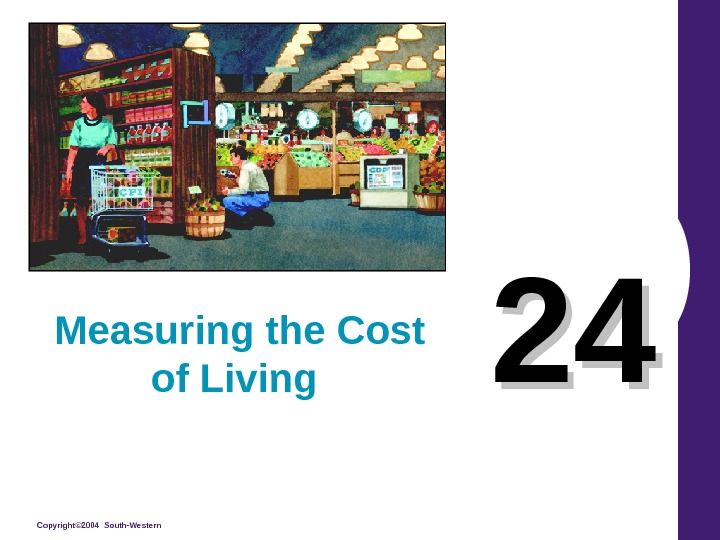
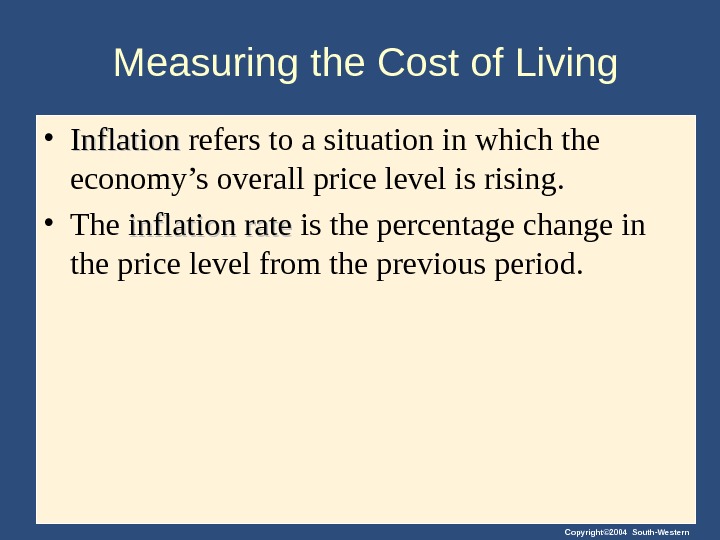



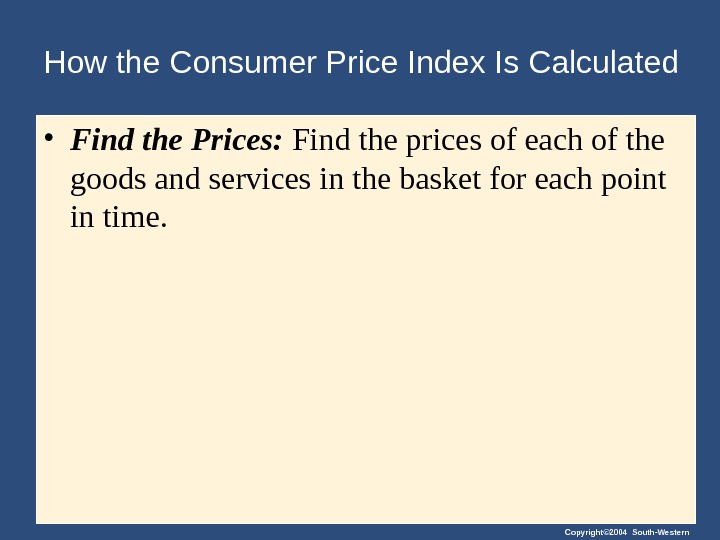







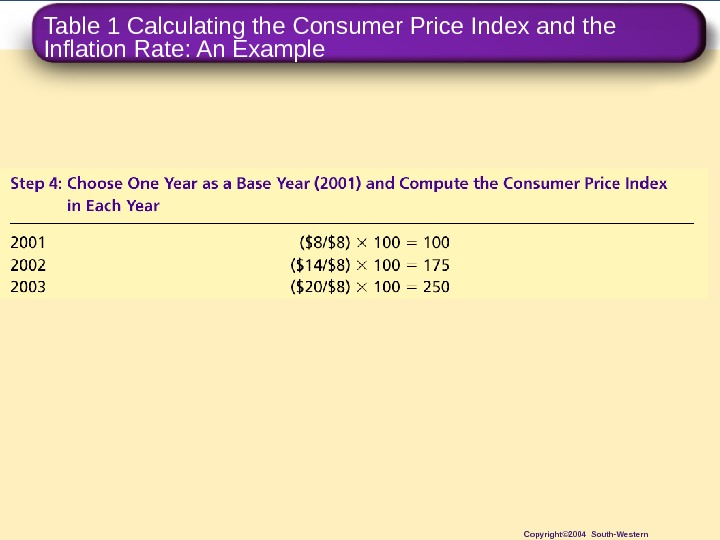








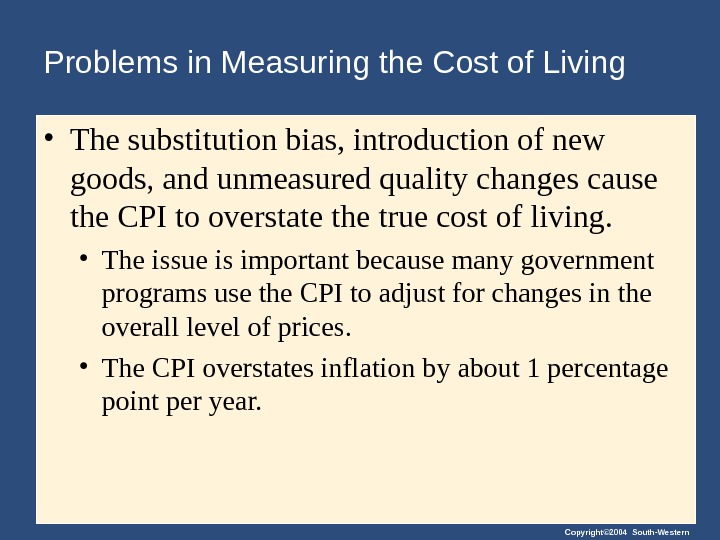
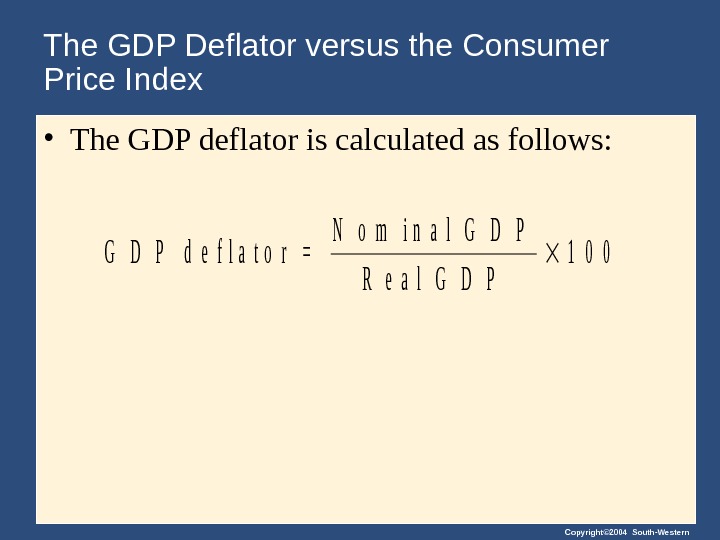


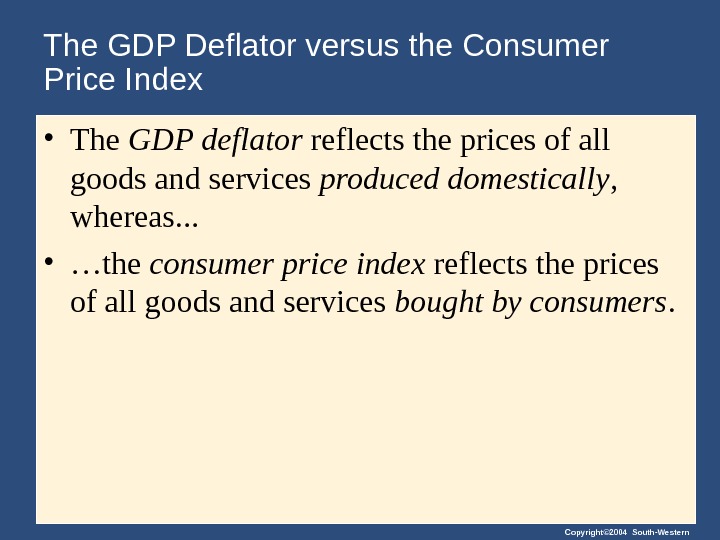




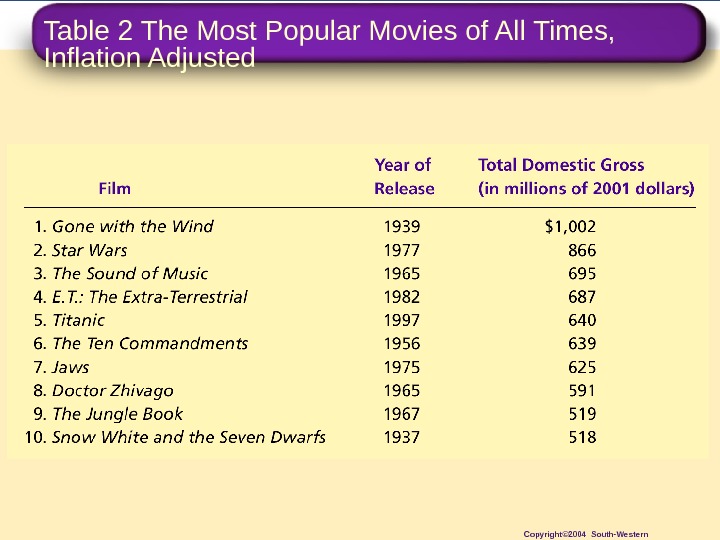

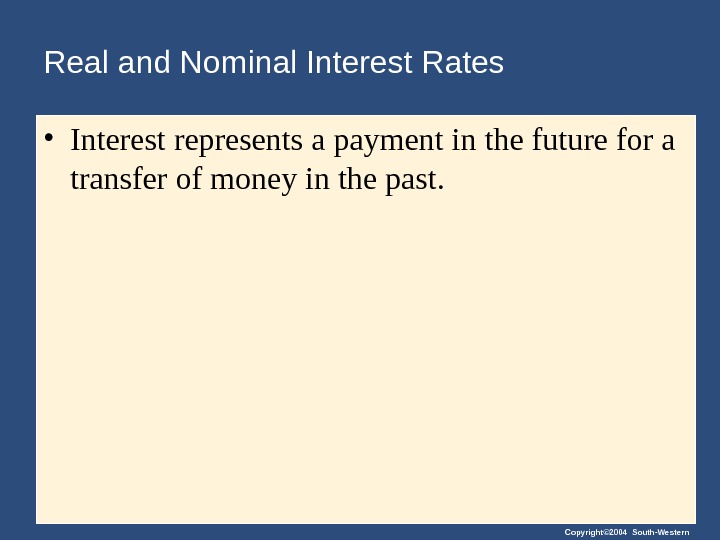
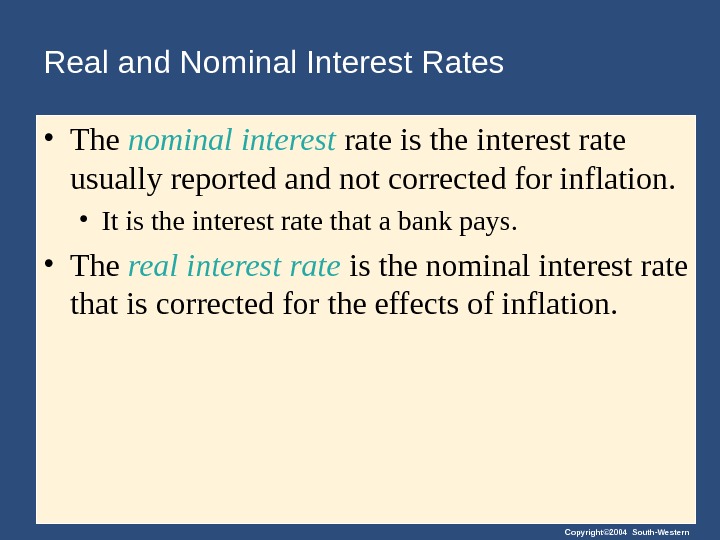

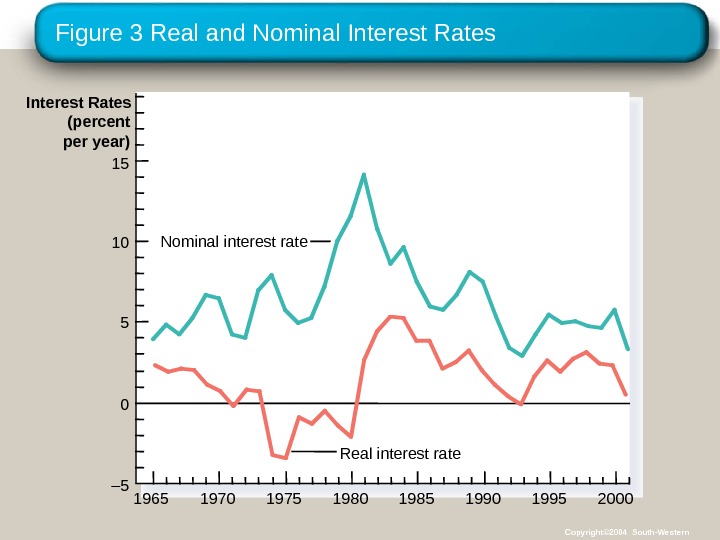




- Размер: 1.9 Mегабайта
- Количество слайдов: 41
Описание презентации Copyright© 2004 South-Western 2424 Measuring the Cost of по слайдам
 Copyright© 2004 South-Western 2424 Measuring the Cost of Living
Copyright© 2004 South-Western 2424 Measuring the Cost of Living
 Copyright© 2004 South-Western. Measuring the Cost of Living • Inflation refers to a situation in which the economy’s overall price level is rising. • The inflation rate is the percentage change in the price level from the previous period.
Copyright© 2004 South-Western. Measuring the Cost of Living • Inflation refers to a situation in which the economy’s overall price level is rising. • The inflation rate is the percentage change in the price level from the previous period.
 Copyright© 2004 South-Western. THE CONSUMER PRICE INDEX • The consumer price index (CPI) is a measure of the overall cost of the goods and services bought by a typical consumer. • The Bureau of Labor Statistics reports the CPI each month. • It is used to monitor changes in the cost of living over time.
Copyright© 2004 South-Western. THE CONSUMER PRICE INDEX • The consumer price index (CPI) is a measure of the overall cost of the goods and services bought by a typical consumer. • The Bureau of Labor Statistics reports the CPI each month. • It is used to monitor changes in the cost of living over time.
 Copyright© 2004 South-Western. THE CONSUMER PRICE INDEX • When the CPI rises, the typical family has to spend more dollars to maintain the same standard of living.
Copyright© 2004 South-Western. THE CONSUMER PRICE INDEX • When the CPI rises, the typical family has to spend more dollars to maintain the same standard of living.
 Copyright© 2004 South-Western. How the Consumer Price Index Is Calculated • Fix the Basket: Determine what prices are most important to the typical consumer. • The Bureau of Labor Statistics (BLS) identifies a market basket of goods and services the typical consumer buys. • The BLS conducts monthly consumer surveys to set the weights for the prices of those goods and services.
Copyright© 2004 South-Western. How the Consumer Price Index Is Calculated • Fix the Basket: Determine what prices are most important to the typical consumer. • The Bureau of Labor Statistics (BLS) identifies a market basket of goods and services the typical consumer buys. • The BLS conducts monthly consumer surveys to set the weights for the prices of those goods and services.
 Copyright© 2004 South-Western. How the Consumer Price Index Is Calculated • Find the Prices: Find the prices of each of the goods and services in the basket for each point in time.
Copyright© 2004 South-Western. How the Consumer Price Index Is Calculated • Find the Prices: Find the prices of each of the goods and services in the basket for each point in time.
 Copyright© 2004 South-Western. How the Consumer Price Index Is Calculated • Compute the Basket’s Cost: Use the data on prices to calculate the cost of the basket of goods and services at different times.
Copyright© 2004 South-Western. How the Consumer Price Index Is Calculated • Compute the Basket’s Cost: Use the data on prices to calculate the cost of the basket of goods and services at different times.
 Copyright© 2004 South-Western. How the Consumer Price Index Is Calculated • Choose a Base Year and Compute the Index: • Designate one year as the base year, making it the benchmark against which other years are compared. • Compute the index by dividing the price of the basket in one year by the price in the base year and multiplying by 100.
Copyright© 2004 South-Western. How the Consumer Price Index Is Calculated • Choose a Base Year and Compute the Index: • Designate one year as the base year, making it the benchmark against which other years are compared. • Compute the index by dividing the price of the basket in one year by the price in the base year and multiplying by 100.
 Copyright© 2004 South-Western. How the Consumer Price Index Is Calculated • Compute the inflation rate: The inflation rate is the percentage change in the price index from the preceding period.
Copyright© 2004 South-Western. How the Consumer Price Index Is Calculated • Compute the inflation rate: The inflation rate is the percentage change in the price index from the preceding period.
 Copyright© 2004 South-Western. How the Consumer Price Index Is Calculated • The Inflation Rate • The inflation rate is calculated as follows: I n f l a t i o n R a t e i n Y ea r 2= C P I i n Y e ar 2 -C P I i n Y e ar
Copyright© 2004 South-Western. How the Consumer Price Index Is Calculated • The Inflation Rate • The inflation rate is calculated as follows: I n f l a t i o n R a t e i n Y ea r 2= C P I i n Y e ar 2 -C P I i n Y e ar
 Table 1 Calculating the Consumer Price Index and the Inflation Rate: An Example Copyright© 2004 South-Western
Table 1 Calculating the Consumer Price Index and the Inflation Rate: An Example Copyright© 2004 South-Western
 Table 1 Calculating the Consumer Price Index and the Inflation Rate: An Example Copyright© 2004 South-Western
Table 1 Calculating the Consumer Price Index and the Inflation Rate: An Example Copyright© 2004 South-Western
 Table 1 Calculating the Consumer Price Index and the Inflation Rate: An Example Copyright© 2004 South-Western
Table 1 Calculating the Consumer Price Index and the Inflation Rate: An Example Copyright© 2004 South-Western
 Table 1 Calculating the Consumer Price Index and the Inflation Rate: An Example Copyright© 2004 South-Western
Table 1 Calculating the Consumer Price Index and the Inflation Rate: An Example Copyright© 2004 South-Western
 Table 1 Calculating the Consumer Price Index and the Inflation Rate: An Example Copyright© 2004 South-Western
Table 1 Calculating the Consumer Price Index and the Inflation Rate: An Example Copyright© 2004 South-Western
 Copyright© 2004 South-Western. How the Consumer Price Index Is Calculated • Calculating the Consumer Price Index and the Inflation Rate: Another Example • Base Year is 2002. • Basket of goods in 2002 costs $1, 200. • The same basket in 2004 costs $1, 236. • CPI = ($1, 236/$1, 200) 100 = 103. • Prices increased 3 percent between 2002 and 2004.
Copyright© 2004 South-Western. How the Consumer Price Index Is Calculated • Calculating the Consumer Price Index and the Inflation Rate: Another Example • Base Year is 2002. • Basket of goods in 2002 costs $1, 200. • The same basket in 2004 costs $1, 236. • CPI = ($1, 236/$1, 200) 100 = 103. • Prices increased 3 percent between 2002 and 2004.
 FYI: What’s in the CPI’s Basket? 16% Food and beverages 17% Transportation Medical care 6% Recreation 6% Apparel 4% Other goods and services 4% 41% Housing 6%Education and communication Copyright© 2004 South-Western
FYI: What’s in the CPI’s Basket? 16% Food and beverages 17% Transportation Medical care 6% Recreation 6% Apparel 4% Other goods and services 4% 41% Housing 6%Education and communication Copyright© 2004 South-Western
 Copyright© 2004 South-Western. Problems in Measuring the Cost of Living • The CPI is an accurate measure of the selected goods that make up the typical bundle, but it is not a perfect measure of the cost of living.
Copyright© 2004 South-Western. Problems in Measuring the Cost of Living • The CPI is an accurate measure of the selected goods that make up the typical bundle, but it is not a perfect measure of the cost of living.
 Copyright© 2004 South-Western. Problems in Measuring the Cost of Living • Substitution bias • Introduction of new goods • Unmeasured quality changes
Copyright© 2004 South-Western. Problems in Measuring the Cost of Living • Substitution bias • Introduction of new goods • Unmeasured quality changes
 Copyright© 2004 South-Western. Problems in Measuring the Cost of Living • Substitution Bias • The basket does not change to reflect consumer reaction to changes in relative prices. • Consumers substitute toward goods that have become relatively less expensive. • The index overstates the increase in cost of living by not considering consumer substitution.
Copyright© 2004 South-Western. Problems in Measuring the Cost of Living • Substitution Bias • The basket does not change to reflect consumer reaction to changes in relative prices. • Consumers substitute toward goods that have become relatively less expensive. • The index overstates the increase in cost of living by not considering consumer substitution.
 Copyright© 2004 South-Western. Problems in Measuring the Cost of Living • Introduction of New Goods • The basket does not reflect the change in purchasing power brought on by the introduction of new products. • New products result in greater variety, which in turn makes each dollar more valuable. • Consumers need fewer dollars to maintain any given standard of living.
Copyright© 2004 South-Western. Problems in Measuring the Cost of Living • Introduction of New Goods • The basket does not reflect the change in purchasing power brought on by the introduction of new products. • New products result in greater variety, which in turn makes each dollar more valuable. • Consumers need fewer dollars to maintain any given standard of living.
 Copyright© 2004 South-Western. Problems in Measuring the Cost of Living • Unmeasured Quality Changes • If the quality of a good rises from one year to the next, the value of a dollar rises, even if the price of the good stays the same. • If the quality of a good falls from one year to the next, the value of a dollar falls, even if the price of the good stays the same. • The BLS tries to adjust the price for constant quality, but such differences are hard to measure.
Copyright© 2004 South-Western. Problems in Measuring the Cost of Living • Unmeasured Quality Changes • If the quality of a good rises from one year to the next, the value of a dollar rises, even if the price of the good stays the same. • If the quality of a good falls from one year to the next, the value of a dollar falls, even if the price of the good stays the same. • The BLS tries to adjust the price for constant quality, but such differences are hard to measure.
 Copyright© 2004 South-Western. Problems in Measuring the Cost of Living • The substitution bias, introduction of new goods, and unmeasured quality changes cause the CPI to overstate the true cost of living. • The issue is important because many government programs use the CPI to adjust for changes in the overall level of prices. • The CPI overstates inflation by about 1 percentage point per year.
Copyright© 2004 South-Western. Problems in Measuring the Cost of Living • The substitution bias, introduction of new goods, and unmeasured quality changes cause the CPI to overstate the true cost of living. • The issue is important because many government programs use the CPI to adjust for changes in the overall level of prices. • The CPI overstates inflation by about 1 percentage point per year.
 Copyright© 2004 South-Western. The GDP Deflator versus the Consumer Price Index • The GDP deflator is calculated as follows: G D P d e f l a to r= N o m i n a l G DP R e a l G D P
Copyright© 2004 South-Western. The GDP Deflator versus the Consumer Price Index • The GDP deflator is calculated as follows: G D P d e f l a to r= N o m i n a l G DP R e a l G D P
 Copyright© 2004 South-Western. The GDP Deflator versus the Consumer Price Index • The BLS calculates other prices indexes: • The index for different regions within the country. • The producer price index , which measures the cost of a basket of goods and services bought by firms rather than consumers.
Copyright© 2004 South-Western. The GDP Deflator versus the Consumer Price Index • The BLS calculates other prices indexes: • The index for different regions within the country. • The producer price index , which measures the cost of a basket of goods and services bought by firms rather than consumers.
 Copyright© 2004 South-Western. The GDP Deflator versus the Consumer Price Index • Economists and policymakers monitor both the GDP deflator and the consumer price index to gauge how quickly prices are rising. • There are two important differences between the indexes that can cause them to diverge.
Copyright© 2004 South-Western. The GDP Deflator versus the Consumer Price Index • Economists and policymakers monitor both the GDP deflator and the consumer price index to gauge how quickly prices are rising. • There are two important differences between the indexes that can cause them to diverge.
 Copyright© 2004 South-Western. The GDP Deflator versus the Consumer Price Index • The GDP deflator reflects the prices of all goods and services produced domestically , whereas. . . • … the consumer price index reflects the prices of all goods and services bought by consumers.
Copyright© 2004 South-Western. The GDP Deflator versus the Consumer Price Index • The GDP deflator reflects the prices of all goods and services produced domestically , whereas. . . • … the consumer price index reflects the prices of all goods and services bought by consumers.
 Copyright© 2004 South-Western. The GDP Deflator versus the Consumer Price Index • The consumer price index compares the price of a fixed basket of goods and services to the price of the basket in the base year (only occasionally does the BLS change the basket). . . • … whereas the GDP deflator compares the price of currently produced goods and services to the price of the same goods and services in the base year.
Copyright© 2004 South-Western. The GDP Deflator versus the Consumer Price Index • The consumer price index compares the price of a fixed basket of goods and services to the price of the basket in the base year (only occasionally does the BLS change the basket). . . • … whereas the GDP deflator compares the price of currently produced goods and services to the price of the same goods and services in the base year.
 Figure 2 Two Measures of Inflation 1965 Percent per Year 15 CPI GDP deflator 10 5 0 1975 1980 1985 1990 20001995 Copyright© 2004 South-Western
Figure 2 Two Measures of Inflation 1965 Percent per Year 15 CPI GDP deflator 10 5 0 1975 1980 1985 1990 20001995 Copyright© 2004 South-Western
 Copyright© 2004 South-Western. CORRECTING ECONOMIC VARIABLES FOR THE EFFECTS OF INFLATION • Price indexes are used to correct for the effects of inflation when comparing dollar figures from different times.
Copyright© 2004 South-Western. CORRECTING ECONOMIC VARIABLES FOR THE EFFECTS OF INFLATION • Price indexes are used to correct for the effects of inflation when comparing dollar figures from different times.
 Copyright© 2004 South-Western. Dollar Figures from Different Times • Do the following to convert (inflate) Babe Ruth’s wages in 1931 to dollars in 2001: S a l a r y P r i c e l e v el i n 2 0 0 1 P r i c e l e v el i n 1 9 3 1 2 0 0 11 9 3 1 $ 8 0, . $ 9 3 1,
Copyright© 2004 South-Western. Dollar Figures from Different Times • Do the following to convert (inflate) Babe Ruth’s wages in 1931 to dollars in 2001: S a l a r y P r i c e l e v el i n 2 0 0 1 P r i c e l e v el i n 1 9 3 1 2 0 0 11 9 3 1 $ 8 0, . $ 9 3 1,
 Table 2 The Most Popular Movies of All Times, Inflation Adjusted Copyright© 2004 South-Western
Table 2 The Most Popular Movies of All Times, Inflation Adjusted Copyright© 2004 South-Western
 Copyright© 2004 South-Western. Indexation • When some dollar amount is automatically corrected for inflation by law or contract, the amount is said to be indexed for inflation.
Copyright© 2004 South-Western. Indexation • When some dollar amount is automatically corrected for inflation by law or contract, the amount is said to be indexed for inflation.
 Copyright© 2004 South-Western. Real and Nominal Interest Rates • Interest represents a payment in the future for a transfer of money in the past.
Copyright© 2004 South-Western. Real and Nominal Interest Rates • Interest represents a payment in the future for a transfer of money in the past.
 Copyright© 2004 South-Western. Real and Nominal Interest Rates • The nominal interest rate is the interest rate usually reported and not corrected for inflation. • It is the interest rate that a bank pays. • The real interest rate is the nominal interest rate that is corrected for the effects of inflation.
Copyright© 2004 South-Western. Real and Nominal Interest Rates • The nominal interest rate is the interest rate usually reported and not corrected for inflation. • It is the interest rate that a bank pays. • The real interest rate is the nominal interest rate that is corrected for the effects of inflation.
 Copyright© 2004 South-Western. Real and Nominal Interest Rates • You borrowed $1, 000 for one year. • Nominal interest rate was 15%. • During the year inflation was 10%. Real interest rate = Nominal interest rate – Inflation = 15% — 10% = 5%
Copyright© 2004 South-Western. Real and Nominal Interest Rates • You borrowed $1, 000 for one year. • Nominal interest rate was 15%. • During the year inflation was 10%. Real interest rate = Nominal interest rate – Inflation = 15% — 10% = 5%
 Figure 3 Real and Nominal Interest Rates 1965 Interest Rates (percent per year) 15 Real interest rate 10 5 0 – 5 1970 1975 1980 1985 1990 1995 2000 Nominal interest rate Copyright© 2004 South-Western
Figure 3 Real and Nominal Interest Rates 1965 Interest Rates (percent per year) 15 Real interest rate 10 5 0 – 5 1970 1975 1980 1985 1990 1995 2000 Nominal interest rate Copyright© 2004 South-Western
 Copyright© 2004 South-Western. Summary • The consumer price index shows the cost of a basket of goods and services relative to the cost of the same basket in the base year. • The index is used to measure the overall level of prices in the economy. • The percentage change in the CPI measures the inflation rate.
Copyright© 2004 South-Western. Summary • The consumer price index shows the cost of a basket of goods and services relative to the cost of the same basket in the base year. • The index is used to measure the overall level of prices in the economy. • The percentage change in the CPI measures the inflation rate.
 Copyright© 2004 South-Western. Summary • The consumer price index is an imperfect measure of the cost of living for the following three reasons: substitution bias, the introduction of new goods, and unmeasured changes in quality. • Because of measurement problems, the CPI overstates annual inflation by about 1 percentage point.
Copyright© 2004 South-Western. Summary • The consumer price index is an imperfect measure of the cost of living for the following three reasons: substitution bias, the introduction of new goods, and unmeasured changes in quality. • Because of measurement problems, the CPI overstates annual inflation by about 1 percentage point.
 Copyright© 2004 South-Western. Summary • The GDP deflator differs from the CPI because it includes goods and services produced rather than goods and services consumed. • In addition, the CPI uses a fixed basket of goods, while the GDP deflator automatically changes the group of goods and services over time as the composition of GDP changes.
Copyright© 2004 South-Western. Summary • The GDP deflator differs from the CPI because it includes goods and services produced rather than goods and services consumed. • In addition, the CPI uses a fixed basket of goods, while the GDP deflator automatically changes the group of goods and services over time as the composition of GDP changes.
 Copyright© 2004 South-Western. Summary • Dollar figures from different points in time do not represent a valid comparison of purchasing power. • Various laws and private contracts use price indexes to correct for the effects of inflation. • The real interest rate equals the nominal interest rate minus the rate of inflation.
Copyright© 2004 South-Western. Summary • Dollar figures from different points in time do not represent a valid comparison of purchasing power. • Various laws and private contracts use price indexes to correct for the effects of inflation. • The real interest rate equals the nominal interest rate minus the rate of inflation.
